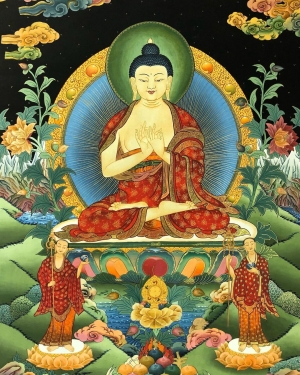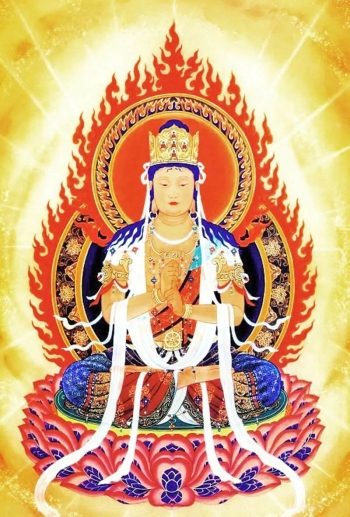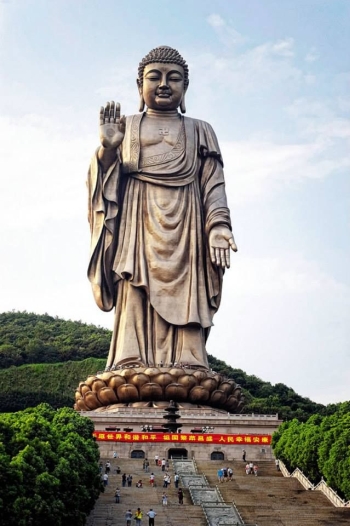Vairocana
1. Vairocana
Vairocana (also Mahāvairocana) is a Cosmic Buddha from Mahāyāna and Vajrayāna Buddhism.
Vairocana is often interpreted, in texts like the Avataṁsaka Sūtra, as the Dharmakāya of the historical Gautama Buddha.
In East Asian Buddhism (Chinese, Korean, Japanese and Vietnamese Buddhism), Vairocana is also seen as the embodiment of the Buddhist concept of Śūnyatā.
In the conception of the 5 Tathāgatas of Mahāyāna and Vajrayāna Buddhism, Vairocana is at the centre and is considered a Primordial Buddha.
2. History of devotion
Vairocana Buddha is first introduced in the Mahāyāna version of Brahmajāla Sūtra:
Now, I, Vairocana Buddha, am sitting atop a lotus pedestal;
On a thousand flowers surrounding me are a thousand Śākyamuni Buddhas. Each flower supports a hundred million worlds; in each world a Śākyamuni Buddha appears. All are seated beneath a Bodhi-tree, all simultaneously attain Buddhahood.
All these innumerable Buddhas have Vairocana as their original body.
Brahmajāla Sūtra
Vairocana is also mentioned in the Avataṁsaka Sūtra;
However, the doctrine of Vairocana is based largely on the teachings of the Mahāvairocana Tantra (also known as the Mahāvairocana-Abhisaṁbodhi-tantra)
and to a lesser degree the Vajraśekhara Sūtra (also known as the Sarva-Tathāgata-tattva-saṁgraha Tantra).
Vairocana is also mentioned as an epithet of Gautama Buddha in the Samantabhadra Meditation Sūtra, who dwells in a place called Always Tranquil Light
.
Vairocana is the Primordial Buddha in the Chinese schools of Tiantai, Huayan and Tangmi, also appearing in later schools including the Japanese Kegon, Shingon and esoteric lineages of Tendai.
In the case of Huayan and Shingon, Vairocana is the central figure.
In Chinese and Japanese Buddhism, Vairocana was gradually superseded as an object of reverence by Amitābha, due in large part to the increasing popularity of Pure Land Buddhism, but veneration of Vairocana still remains popular among adherents.
During the initial stages of his mission in Japan, the Catholic missionary Francis Xavier (1506 - 1552) was welcomed by the Shingon monks since he used Dainichi, the Japanese name for Vairocana, to designate the Christian God.
As Xavier learned more about the religious nuances of the word, he substituted the term Deusu, which he derived from the Latin and Portuguese Deus.
The Shingon monk Dohan regarded the 2 great Buddhas, Amitābha and Vairocana, as one and the same Dharmakāya Buddha and as the true nature at the core of all beings and phenomena.
There are several realizations that can accrue to the Shingon practitioner of which Dohan speaks in this connection:
There is the realization that Amida is the Dharmakāya Buddha, Vairocana;
then there is the realization that Amida as Vairocana is eternally manifest within this universe of time and space;
and finally there is the inner most realization that Amida is the true nature, material and spiritual, of all beings, that he is the wisdom-body, that he is the unborn, unmanifest, unchanging reality that rests quietly at the core of all phenomena.
Dohan
Mahāvairocana’s virtues are deemed to be immanently universal within all beings:
The principle doctrine of the Dainichi is that all the virtues of Dainichi (Mahāvairocana) are inherent in us and in all sentient beings.
In the Śūraṅgama mantra (Chinese: Léngyán Zhòu) taught in the Śūraṅgama Sūtra (Chinese: Léngyán Jīng), an especially influential dhāraṇī in the Chinese Chan tradition,
Vairocana is mentioned to be the host of the Buddha Division in the centre, one of the 5 major divisions which dispel the vast demon armies of the 5 directions.
3. Statues
With regard to Śūnyatā, the massive size and brilliance of Vairocana statues serve as a reminder that all conditioned existence is empty and without a permanent identity, whereas the Dharmakāya is beyond concepts.
The Spring Temple Buddha of Lushan County, Henan, China, with a height of 126 meters, is the 2nd tallest statue in the world.
The Daibutsu, the Giant Buddha in the Tōdai-ji in Nara, Japan is the largest bronze image of Vairocana in the world.
The larger of the Buddhas of Bāmiyān in Afghanistan that were destroyed by Taliban was also a depiction of Vairocana.
In Java, Indonesia, the 9th-century Mendut temple near Borobudur in Magelang was dedicated to the Dhyāna Buddha Vairocana:
Built by the Śailēndra dynasty, the temple featured a 3-meter tall stone statue of Vairocana, seated and performing the Dharmacakra mudra. The statue is flanked with statues of the Bodhisattvas Avalokiteśvara and Vajrapāṇi.
4. Mantra
The seed syllable of Vairocana is the letter Ā (अ:). It is often used for meditation purposes, as a sound and also as an object of concentration.
The basic Vairocana Mantra is:
Oṁ Vairocana Hūṁ
His mantra in Shingon Buddhism is:
(Sanskrit) Oṁ A Vi Ra Hūṁ Khaṁ Vajradhātu Vaṁ (Shingon) on abiraunken basara datoban
There is also the popular Mantra of Light that I already described in a separate article:
Oṁ Amogha Vairocana Mahāmudrā Maṇipadma Jvāla Pravartāya Hūṁ



